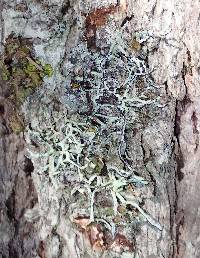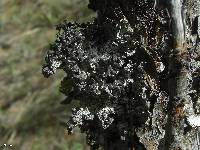
Consortium of Lichen Herbaria
- building a Global Consortium of Bryophytes and Lichens as keystones of cryptobiotic communities -
- Home
- Search
- Images
- Species Checklists
- US States: O-Z >
- US National Parks
- Central America
- South America
- US National Parks
- Southern Subpolar Region
|
|
|
|
Family: Parmeliaceae
|
Nash, T.H., Ryan, B.D., Gries, C., Bungartz, F., (eds.) 2002. Lichen Flora of the Greater Sonoran Desert Region. Vol 1. Thallus: erect to suberect, up to 8 (-13) cm broad or long; texture: cartilaginous; branching: isotomic dichotomous to irregular; budding: absent or rare lobes: separate to centrally contiguous, 0.3-2 (-4) mm broad, sometimes black bordered; profile: even; width/height ratio: 1-3; tips and axils: rarely perforate upper surface: white to greenish gray or brown, sometimes dark mottled, smooth to rugose; soredia and isidia: absent; lobules: sparse or lacking medulla: hollow, semi-solid, or solid; ceiling of cavity white, floor of cavity white lower surface: black, rarely perforate Apothecia: common, substipitate to stipitate, up to 10 (-20) mm in diam; stipe: mainly funnel-shaped, hollow; disc: light brown to dark red brown ascospores: broadly ellipsoid, 6.3-8 x 3.8-5.2 µm Pycnidia: common conidia: rod-shaped, 7-7.5 x 0.5-0.6 µm Spot tests: cortex K+ yellow, C-, KC-, P+ pale yellow, UV-; medulla K-, C-, KC+ orange-red, P- or P+ orange-red, occasionally P+ yellow Secondary metabolites: upper cortex with atranorin and chloroatranorin; medullary chemistry highly variable, containing virtually all combinations of diffractaic acid (minor, accessory), physodic acid (major), physodalic acid (major), protocetraric acid (minor), 3-hydroxyphysodic acid (minor, frequency about 20%), 2'-O-methylphysodic (minor accessory), and various accessory unknowns. The most frequent chemotype is P+, with diffractaic, physodic, physodalic, and protocetraric acids. Also common is a P- chemotype with physodic acid as the only major substance in the medulla. Substrate and ecology: on bark or wood, including both conifers and hardwoods, occurring in a wide range of habitats, including semi-arid suboceanic forest, oceanic woodlands and forests World distribution: western North America, Alaska to northern Baja California, inland to Sierra Nevada, Montana, and Alberta Sonoran distribution: coast ranges and offshore islands of California and northern Baja California. Notes: Hypogymnia imshaugii is extremely variable in morphology and chemistry, probably reflecting multiple closely related species or phenotypic plasticity, or both. The most typical form occurring throughout its range has imperforate lobe tips, hollow lobes, open, dichotomous branching, suberect or erect lobes, and medulla P+ orange. This form is infrequent in southern California. Another form is restricted to southern California and is very compact and appressed, with compressed to folded, hollow lobes, usually P-, and a distinctive set of unknowns by TLC. A third form, also restricted to southern California, has lobes collapsed and ± channeled on the lower surface, semi-solid to solid, with or without extended lobes that are hollow, not black mottled, the central part of the upper cortex strongly rugose, and medulla P+ orange. This form can have sparse subapical and subaxillary perforations, suggesting a relationship to H. gracilis. |
|
|
|
Powered by Symbiota













































































































